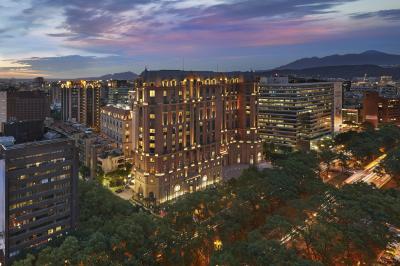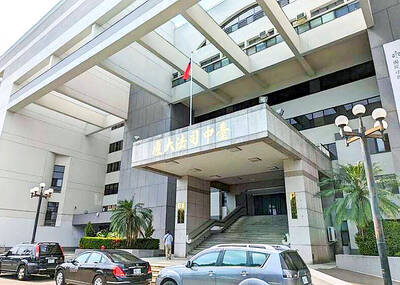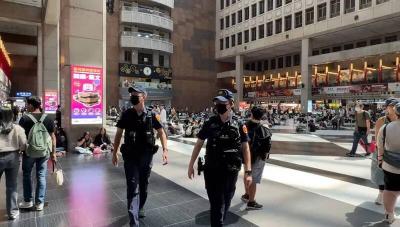As Tropical Storm Bebinca barrels toward waters off northern Taiwan gathering strength into a possible typhoon, weather forecasters in Taipei are using a new and so far successful method to help track its path: artificial intelligence (AI).
AI-generated forecasts, some powered by software from tech giants including Nvidia, whose chips are made by Taiwan’s homegrown semiconductor champion Taiwan Semiconductor Manufacturing Co, have so far outperformed traditional methods in predicting typhoon tracks.
In July, it was AI-based weather models, used for the first time, that helped Taiwan better predict the path and impact of Typhoon Gaemi, the strongest to strike the nation in eight years that brought record-breaking rainfall.

Photo: Liao Chen-huei, Taipei Times
The new technology impressed Taiwanese forecasters by predicting a direct hit as early as eight days before Gaemi made landfall, handily outperforming conventional methods, which remain the mainstay of prediction planning.
“People are starting to realize AI indeed delivered some stunning performances compared to conventional models,” Taiwan Integrated Disaster Prevention of Technology Engineering Consulting Co director Chia Hsin-sing (賈新興) said.
Bebinca is being tracked using the same AI tools by people including Lin Ping-yu (林秉煜), a forecaster at the Central Weather Administration (CWA), who said that AI has given the agency a higher degree of confidence there would not be a direct hit.
“This [AI] is a good thing for us. It is like having one more useful tool to use,” Lin said.
The AI weather programs on offer include Nvidia’s FourCastNet, Google’s GraphCast and Huawei’s Pangu-Weather, as well as a deep learning-based system by the European Centre for Medium-Range Weather Forecasts.
“It is a hotly watched competition. We will know soon who is winning,” Chia said.
Such AI models have also begun to be used to predict storms and hurricanes in other regions with good accuracy, forecasters and academics say.
The AI-based software is trained using historical weather data to learn the cause and effect relationships of meteorological systems and can predict hundreds of weather variables days in advance — a process that requires only a few minutes to complete.
For all the typhoons in the western Pacific this year until the middle of this month, AI’s accuracy in predicting storm tracks over a three-day window was nearly 20 percent higher than that of conventional models, data compiled by the CWA showed.
Ahead of Gaemi, AI helped the CWA foresee an unusual loop in its path that prolonged its impact on Taiwan and prompted it to swiftly issue a rare warning for rainfall of 1.8m, which was later proven accurate, CWA Deputy Administrator Lu Kuo-chen (呂國臣) said.
AI “boosted the confidence for forecasters to make that prediction,” Lu said, adding that the early warning gave extra time for authorities to carry out preparations.
Lu is also pinning hopes on a partnership with Nvidia, which this year announced a generative AI tool called CorrDiff that aims to forecast more precise locations of typhoon landfall and provide higher resolution images inside a storm.
“We are seeing the potential,” Lu said.
However, for now experts say the AI tools were not able to deliver quality forecasts for more detailed impact of a typhoon, such as its strength and winds, and more time is needed for the new technology to solidify its lead over more traditional ways.
“Was it just good luck?” Chia asked, pointing to AI’s stellar performance on Gaemi. “We need to give AI a bit more time. It is something to look forward to.”
AI is also being used to forecast wave patterns, with the system expected to be fully operational by 2026 in 16 of the 22 administrative regions in Taiwan, the CWA said.
Twelve monitoring stations and several forecasting systems have been established nationwide to improve safety for recreational water activities, the agency said.
Pilot programs are under way along the north coast and at the Northeast and Yilan Coast National Scenic Area, it said.
The CWA said it has partnered with local research institutions to develop rip current monitoring and forecasting tools.
Using AI, they are producing detailed wave forecasts to enhance the safety of coastal recreation and other operations, it added.
Additional reporting by CNA

The first global hotel Keys Selection by the Michelin Guide includes four hotels in Taiwan, Michelin announced yesterday. All four received the “Michelin One Key,” indicating guests are to experience a “very special stay” at any of the locations as the establishments are “a true gem with personality. Service always goes the extra mile, and the hotel provides much more than others in its price range.” Of the four hotels, three are located in Taipei and one in Taichung. In Taipei, the One Key accolades were awarded to the Capella Taipei, Kimpton Da An Taipei and Mandarin Oriental Taipei. Capella Taipei was described by

EVA Airways today confirmed the death of a flight attendant on Saturday upon their return to Taiwan and said an internal investigation has been launched, as criticism mounted over a social media post accusing the airline of failing to offer sufficient employee protections. According to the post, the flight attendant complained of feeling sick on board a flight, but was unable to take sick leave or access medical care. The crew member allegedly did not receive assistance from the chief purser, who failed to heed their requests for medical attention or call an ambulance once the flight landed, the post said. As sick

The Taichung District Court yesterday confirmed its final ruling that the marriage between teenage heir Lai (賴) and a man surnamed Hsia (夏) was legally invalid, preventing Hsia from inheriting Lai’s NT$500 million (US$16.37 million) estate. The court confirmed that Hsia chose not to appeal the civil judgement after the court handed down its ruling in June, making the decision final. In the June ruling, the court said that Lai, 18, and Hsia, 26, showed “no mutual admiration before the marriage” and that their interactions were “distant and unfamiliar.” The judge concluded that the couple lacked the “true intention of

A drunk woman was sexually assaulted inside a crowded concourse of Taipei Railway Station on Thursday last week before a foreign tourist notified police, leading to calls for better education on bystander intervention and review of security infrastructure. The man, surnamed Chiu (邱), was taken into custody on charges of sexual assault, taking advantage of the woman’s condition and public indecency. Police discovered that Chiu was a fugitive with prior convictions for vehicle theft. He has been taken into custody and is to complete his unserved six-month sentence, police said. On Thursday last week, Chiu was seen wearing a white